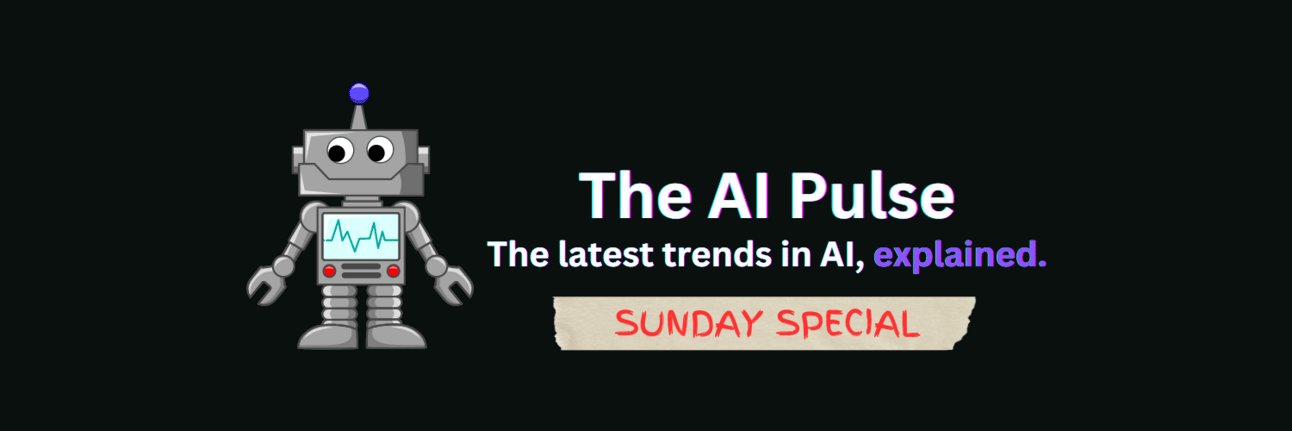
Welcome back AI prodigies!
In today’s Sunday Special:
🤖What AI Is and Isn’t
🥛Glass is Like AI
💪Man > Machine
🔑Key Takeaway
Read Time: 6 minutes
🎓Key Terms
Blockchain: a decentralized, immutable, public ledger that records transactions to prevent tampering.
Web 3.0: a decentralized version of the internet where users control their data.
Caustics: the curved patterns formed when light reflects off a curved surface.
Pytorch: an open-source framework used to build Deep Neural Networks (DNNs) that help AI models get smarter.
Generative AI (GenAI): AI that creates new things like text, images, video, audio, and code.
🩺 PULSE CHECK
Do AI’s quick responses to questions make it intelligent?
🤖WHAT AI IS AND ISN’T
AI has become a buzzword, a far outcry from its inception. AI is often used with blockchain, Web 3.0, and a litany of unrelated technology trends. In confounding AI with technology in general, some casual observers have begun to glamorize AI, mistakenly believing that, at present, AI is much more impactful than it is.
Just because Chief Executive Officers (CEOs) say their technology uses AI doesn’t mean it does. During the first three months of 2024, Fortune 500 CEOs cited “AI” an average of 11 times on earning calls, with Meta executives mentioning it 96 times, or nearly twice per minute. Even if a technology uses AI, the haphazard inclusion of AI doesn’t automatically make it better. If duct tape suddenly became a trendy technology, startups would start slapping duct tape on their keyboards just so they could say, “Made with duct tape.” Large corporations would put little pieces of duct tape on existing products or services to say, “Now made with duct tape.” This executive strategy doesn’t make duct tape any less useful, but it makes it challenging to discern its utility. AI is a tool; in many ways, it’s the software equivalent of duct tape.
Duct tape is a versatile tool with applications ranging from aviation to race cars, but it’s not a structural material that replaces long-term repairs. Similarly, AI excels in certain areas, shows surprising capabilities in others, and has limitations.
🥛GLASS IS LIKE AI
Generative AI (GenAI) has revolutionized technology by enabling computers to generate human-quality content and mimic human creativity. GenAI can answer user queries in seconds or instantly generate images, videos, or music. Everything is nearly instantaneous. Creators leverage MidJourney to generate video thumbnails and article visualizations. Writers use Anthropic’s Claude to analyze human text. The list of things GenAI excels at is growing at a rapid rate, and many people are adding it to their toolkit to get higher-quality work done faster.
If AI can do all these complicated human things and do more and more of them, isn’t it reasonable to think it'll keep improving? If it’s already better than humans at many things, when will it be better at everything? Not in the foreseeable future. To understand why AI is dumb, we’ll recall how AI works based on something everyone understands—light.
Light hitting a curved, transparent surface can create beautiful patterns called caustics; think about those weird light rings on the bottom of a pool. The Swiss Federal Institute of Technology Lausanne (EPFL) figured out how to manufacture various forms of glass so artists could produce artistic works with it. Though this is novel, impressive, and useful, no one would dare call the piece of glass smart? Glass is dumb, but the people who made the glass are smart. Just because the glass produced a beautiful image doesn’t mean the glass itself is smart.
In this way, AI is like multiple pieces of fancy glass, filtering some input to achieve some output. You change what goes into the AI model, and the output changes. Except instead of light, it’s things like words, images, and videos. All the cutting-edge AI you use is a filter that turns your input into some output. For example, Grammarly recommended I capitalize the word “glass” consistently, even when some instances of “glass” began sentences. Outputs (e.g., Grammarly recommendations) are only as good as the AI model training that involves humans teaching it how to “think.”
💪MAN > MACHINE
Humans are incredibly complex organisms that evolved through billions of years and adapted to various environments. Using our brains, senses, and agile bodies, we rose to the top of a highly competitive food chain where life and death were at stake. We used our heightened place on the food chain to win bounty consistently and, throughout millennia, used the excess calories to evolve the most complex computational system the world has ever seen: the human brain.
We’re born with a complex brain that evolves over our lives, constantly changing based on how we interact with the world, others, and ourselves. In this development, we seek new challenges to strengthen our minds and seek new ideas to test the limits of what’s possible. Some of us find mates and create new humans who inherit a mixture of information from their parents to further the continuum of humanity into future eons.
To train an AI model, you import PyTorch into your codebase, load some examples of images labeled cats or dogs, and adjust the parameters within the AI model until it gets the answer right most of the time. Though this is a trivial example, the underlying principle holds: AI only appears smart because humans trained it to mimic human thought.
AI only gets compared to humans because it’s designed to do what humans can, and it automates narrowly defined tasks that don’t require human instinct, ethical trade-offs, emotional decision-making, or a variety of other inherently human elements. Nevertheless, AI can produce content that, a few years ago, most people would have deemed “man-made.” To some, this warrants some version of the “intelligent” label. To us, it warrants a defense of AI’s imitative nature. When answering a user query, OpenAI’s ChatGPT could preface the response with this statement:
“Based on all of the things I’ve seen humans say, this is a reasonable response to the prompt I’ve been given.”
AI models are trained on vast amounts of real-world data with human examples, which the AI models use to generate impressive outputs. While these responses may seem like original thoughts, they’re sophisticated pattern-matching responses based on the information the AI models have been exposed to. For example, OpenAI’s ChatGPT can quickly suggest recipe ideas based on your fridge contents by recognizing similar patterns in its training datasets. Essentially, AI is highly skilled at imitating human thought processes, but it doesn’t truly think independently. Some incorrectly assume that the AI “thought” of the answer rather than the more accurate conceptualization that the AI recalled the answer based on a complex combination of human examples.
Humans must carefully tailor these AI models to create high-quality outputs. Making an AI model requires massive computers, massive amounts of high-quality reference data to learn from, and vast amounts of time. And they still get stupid things wrong. Sure, humans get things wrong, too, but AI gets them wrong consistently and needs to be corrected. AI needs humans to determine why the AI model is making mistakes; humans need to tweak the AI model to get better outputs. Sometimes it works, and sometimes it doesn’t. The CEOs of big AI companies know this very well, but they want to keep the hype up to keep the money flowing.
🔑KEY TAKEAWAY
AI is nowhere near as complex as humans. AI can only do things humans can do because they’re designed to mimic people. Even with billions of dollars, it’s still hard to make AI models that are smart and useful.
That doesn’t mean AI isn’t powerful; like duct tape, it has various applications. But just because duct tape is useful doesn’t mean it’s intelligent. Could AI be “generally intelligent” in the future? The potential is there.
📒FINAL NOTE
If you found this useful, follow us on Twitter or provide honest feedback below. It helps us improve our content.
How was today’s newsletter?
❤️TAIP Review of the Week
“I work at a SaaS startup. This newsletter’s content is up-to-date, accurate, and well-written. Great work!”
REFER & EARN
🎉Your Friends Learn, You Earn!
{{rp_personalized_text}}
Refer 5 friends to enter 🎰July’s $200 Gift Card Giveaway.
Copy and paste this link to others: {{rp_refer_url}}
